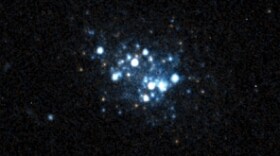An Indiana University scientist has announced a discovery about the mysterious nature of neutrinos, the subatomic “ghost particle” that has captured the imagination of the physics world.
Neutrinos, the second-most abundant particle in the universe, are everywhere, and yet they stubbornly don’t want to cooperate with many of the forces that hold matter together, which makes conducting research on them difficult.
Scientists have figured out ways to study them though. One experiment involves shooting a beam of the particles from Fermilab near Chicago to a lab in a site in northern Minnesota and studying how certain neutrinos change (or, in physics-speak, “oscillate”) across distances.
Mark Messier, IU physicist and spokesman for Fermilab’s “NOvA” experiment, said neutrinos have three mass states – essentially three different sizes – and three “flavor” states. When neutrinos move through space, sometimes their “flavor” changes. By studying those changes, scientists can learn about the composition of the particles.
Even though a neutrino can sport three mass states and three flavor states, the properties don’t always line up with each other. (And to make things more complicated, a neutrino can be several different states at once.) Messier said a recent discovery from NOvA shows one of the mass states doesn’t have the proportion of flavors physicists originally believed—the mix of two flavors wasn’t as equal (or “symmetrical”) as previously thought.
“The way that symmetry breaks and in what direction it breaks could give us another clue about what pattern is behind the scenes that’s making these neutrinos combine in the way that they are to give us the flavors that we see,” he said.
The more scientists know about how a neutrino’s proportions of flavors and masses play against each other, the more they can understand about the role the particles play in the universe, he said.
“So what we want to know is what the recipe is for these neutrinos,” Messier said. “We want to know how much of the three masses we need to combine to produce a neutrino with definite flavors.”
Symmetry is a quality that physicists pay attention to, explained Fermilab scientist Deborah Harris. When there’s symmetry, there’s an indication that some fundamental quality is being conserved (a principle known as Noether’s theorem, named for its author, one of the mothers of theoretical physics.) That the NOvA discovery showed a symmetry “break,” in one of the neutrino mass states makes things somewhat more complicated (and more interesting) for particle physicists.
Harris explained the elusive neutrino can serve as a kind of particle fossil.
“Because they almost never interact, they are messengers from far away,” she said. “We can use them to try make measurements of lots of different things. We can use neutrinos to learn about the sun, to learn about the stars, to learn about even the birth of the universe.”
The results were presented earlier this month at Chicago’s International Conference of High-Energy Physics.
Reporter's note: A previous version of this story indicated the NOvA experiment beamed neutrinos to an abandoned mine in northern Minnesota. This is, in fact, the MINOS experiment, a predecessor to NOvA.)
Additionally, the earlier version said in Noether's theorem, symmetry is an indication of conservation of energy, when in fact this can apply to other fundamental qualities as well.






